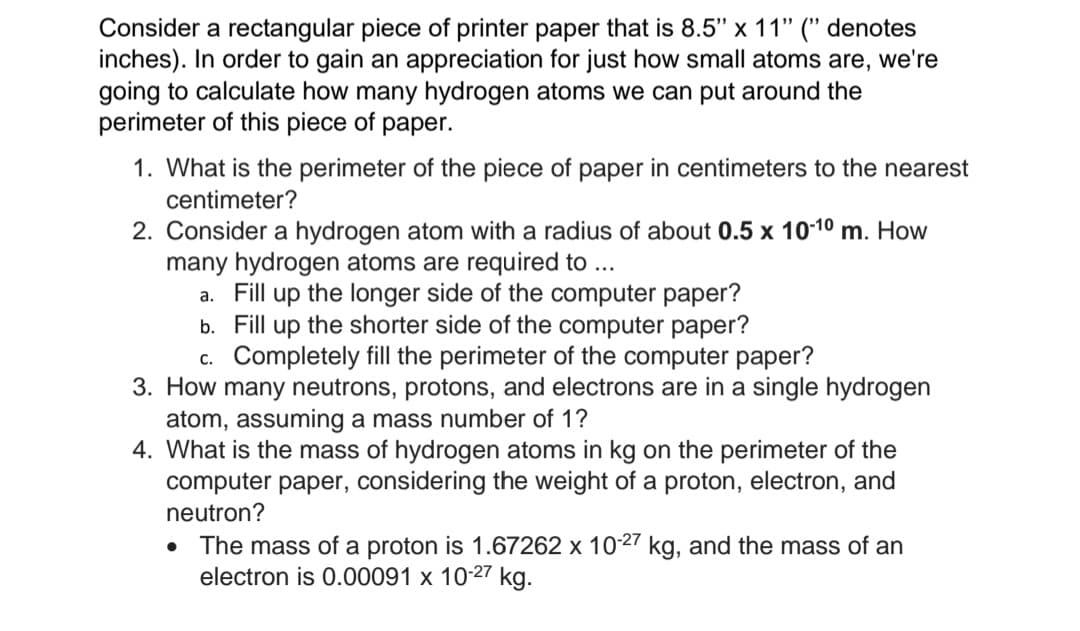Consider a rectangular piece of printer paper that is 8.5" x 11" (" denotes inches). In order to gain an appreciation for just how small atoms are, we're going to calculate how many hydrogen atoms we can put around the perimeter of this piece of paper. 1. What is the perimeter of the piece of paper in centimeters to the nearest centimeter? 2. Consider a hydrogen atom with a radius of about 0.5 x 10-10 m. How many hydrogen atoms are required to ... a. Fill up the longer side of the computer paper? b. Fill up the shorter side of the computer paper? c. Completely fill the perimeter of the computer paper? 3. How many neutrons, protons, and electrons are in a single hydrogen atom, assuming a mass number of 1?
Consider a rectangular piece of printer paper that is 8.5" x 11" (" denotes inches). In order to gain an appreciation for just how small atoms are, we're going to calculate how many hydrogen atoms we can put around the perimeter of this piece of paper. 1. What is the perimeter of the piece of paper in centimeters to the nearest centimeter? 2. Consider a hydrogen atom with a radius of about 0.5 x 10-10 m. How many hydrogen atoms are required to ... a. Fill up the longer side of the computer paper? b. Fill up the shorter side of the computer paper? c. Completely fill the perimeter of the computer paper? 3. How many neutrons, protons, and electrons are in a single hydrogen atom, assuming a mass number of 1?
Principles of Modern Chemistry
8th Edition
ISBN:9781305079113
Author:David W. Oxtoby, H. Pat Gillis, Laurie J. Butler
Publisher:David W. Oxtoby, H. Pat Gillis, Laurie J. Butler
Chapter2: Chemical Formulas, Equations, And Reaction Yields
Section: Chapter Questions
Problem 17P: A gaseous binary compound has a vapor density that is 1.94 times that of oxygen at the same...
Related questions
Question

Transcribed Image Text:Consider a rectangular piece of printer paper that is 8.5" x 11" (" denotes
inches). In order to gain an appreciation for just how small atoms are, we're
going to calculate how many hydrogen atoms we can put around the
perimeter of this piece of paper.
1. What is the perimeter of the piece of paper in centimeters to the nearest
centimeter?
2. Consider a hydrogen atom with a radius of about 0.5 x 10-10 m. How
many hydrogen atoms are required to ...
a. Fill up the longer side of the computer paper?
b. Fill up the shorter side of the computer paper?
c. Completely fill the perimeter of the computer paper?
3. How many neutrons, protons, and electrons are in a single hydrogen
atom, assuming a mass number of 1?
4. What is the mass of hydrogen atoms in kg on the perimeter of the
computer paper, considering the weight of a proton, electron, and
neutron?
The mass of a proton is 1.67262 x 1027 kg, and the mass of an
electron is 0.00091 x 10-27 kg.
Expert Solution
This question has been solved!
Explore an expertly crafted, step-by-step solution for a thorough understanding of key concepts.
Step by step
Solved in 3 steps with 3 images

Knowledge Booster
Learn more about
Need a deep-dive on the concept behind this application? Look no further. Learn more about this topic, chemistry and related others by exploring similar questions and additional content below.Recommended textbooks for you

Principles of Modern Chemistry
Chemistry
ISBN:
9781305079113
Author:
David W. Oxtoby, H. Pat Gillis, Laurie J. Butler
Publisher:
Cengage Learning

Chemistry by OpenStax (2015-05-04)
Chemistry
ISBN:
9781938168390
Author:
Klaus Theopold, Richard H Langley, Paul Flowers, William R. Robinson, Mark Blaser
Publisher:
OpenStax


Principles of Modern Chemistry
Chemistry
ISBN:
9781305079113
Author:
David W. Oxtoby, H. Pat Gillis, Laurie J. Butler
Publisher:
Cengage Learning

Chemistry by OpenStax (2015-05-04)
Chemistry
ISBN:
9781938168390
Author:
Klaus Theopold, Richard H Langley, Paul Flowers, William R. Robinson, Mark Blaser
Publisher:
OpenStax


Introductory Chemistry: A Foundation
Chemistry
ISBN:
9781337399425
Author:
Steven S. Zumdahl, Donald J. DeCoste
Publisher:
Cengage Learning


Chemistry
Chemistry
ISBN:
9781305957404
Author:
Steven S. Zumdahl, Susan A. Zumdahl, Donald J. DeCoste
Publisher:
Cengage Learning